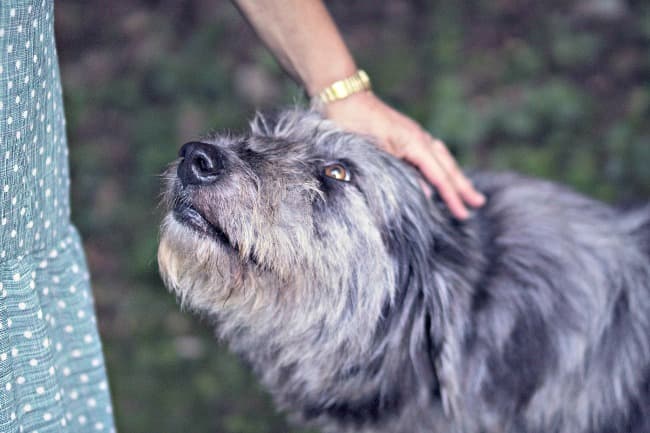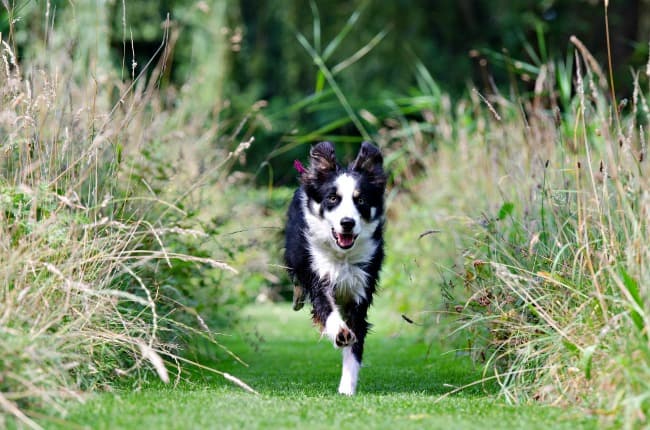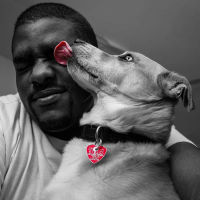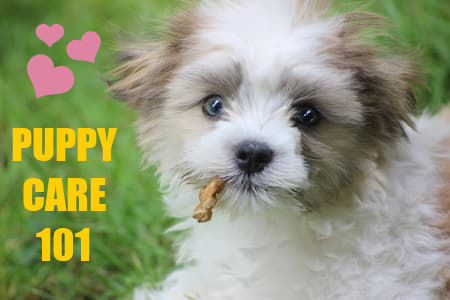FYI: If you buy something through a link on this site I may earn a commission - at NO extra cost to you.
Why Do Dogs Whine?
There are actually lots of answers to the question 'why do dogs whine?'. Dogs don't whine for no reason, so if your dog won't stop whining he's trying to tell you something. The challenge is to find out exactly what that may be! Because dog whining is a fairly versatile form of communication it's important to pay attention to other, accompanying behaviors, which can help point you in the right direction.
So, let's first take a look at the most common reasons for dog whining (these are in alphabetical order, not order of importance or frequency etc.):
- Anxiety
- Aging
- Attention seeking
- Boredom
- Discomfort
- Excitement
- Fear
- Happiness
- Loneliness
- Pain
- Stress
- Submissiveness

Important warning
If your dog keeps whining and this is out of character for him, or he also seems distressed or unwell, it's important to have your veterinarian check him out quickly.
Signs of a veterinary emergency aren't always clear cut, and the symptoms of pain can look similar to stress or anxiety at times, so it's always better to be safe than sorry.
Common reasons why dogs whine
As you can see from the list above, your dog vocalizes many emotions by whining, some are positive ones, some negative. Sometimes there's an obvious reason, sometimes not, but there IS always a reason.
Now we'll look a little more closely at each type of whining to help you figure out what's behind all that noise.
Anxiety
It's usually fairly easy to spot the anxious dogs. They express their feelings clearly by using body language and vocalizations. Other behaviors which often accompany anxious whining, include:
- Pacing
- Panting
- Shaking or shivering
- Drooling
- Lowered body posture and/or tail
- Avoidance of eye contact
- Yawning
- Lip licking
- Loss of bladder or bowel control
Separation anxiety causes extreme distress and the whining can be very high pitched and frantic in this situation.
A new puppy or new dog may whine a lot at first because he feels anxious, homesick and lost.
Strangers in the home, a house move, a new baby or new pet... there are all kinds of things which can affect your dog's emotional state and cause him to be anxious, whiney and upset.
Aging
Older dogs are at risk of a variety of physical and emotional problems which can result in discomfort, pain, anxiety and more.
When this happens whining is often one way they express their distress.
If an old dog is whining it could be because of chronic pain such as the joint pain caused by arthritis, or abdominal pain due to liver or kidney problems, or even cancer.

Old dogs can become confused and disoriented, and even suffer from age-related cognitive decline in the same way humans can.
Of course they don't understand what's happening and this causes anxiety, stress and emotional upset... which results in whining, along with other behaviors such as pacing, shaking, night waking, confusion, memory loss and so on.
Check out these pages to learn more about senior dog behavior and their health.
attention seeking
Sometimes your dog is whining simply because he wants attention.
Maybe it's past dinner time, or walkies time, or he wants a taste of that sandwich you're eating!
This type of whining is natural, albeit sometimes annoying. If you ignore his whining your dog may resort to pawing at you, nuzzling into you or even barking.
After all, as every toddler knows, even negative attention is attention, and that's what he wants.
boredom
Whining from boredom is closely related to the attention seeking whiney behavior.
If you're busy and your dog wants to play, or be petted, or even just noticed, he may whine, bark or paw/nuzzle at you.
A dog who is chronically bored or not getting enough physical or mental stimulation can develop OCD behaviors such as excessive licking, or even become destructive.
discomfort
Whining is often a dog's way of expressing discomfort or distress.
There could be many different reasons for this, for example he could be too hot, feeling nauseous, need a potty break, be itchy, sore, or any number of other things.
He knows something is 'off' but isn't sure what it is and is alerting you to the problem, as well as venting his feelings.
excitement
When dogs are excited they can share their feelings by whining.
Often this kind of dog whining is accompanied by jumping, running in circles, excessive tail wagging and licking.
Your dog might whine excitedly whenever you come home (even if you've only been gone 10 minutes), or when he sees you getting ready to take him on a walk, or preparing dinner, or when he sees a friend.

fear
If your dog is scared he may whine to show his fear and anxiety.
Many dogs are afraid of loud noises such as thunderstorms or fireworks which leads to noise-related anxiety. Some dogs are very sensitive to emotions and human arguments, shouting or tensions can make them upset.
Other signs your dog is scared could include panting, drooling, shaking, or hiding.
happiness
A happy dog behaves just like an excited dog.
Lots of tail wagging, licking, running, jumping... and whining. Barking isn't off the table either!
Your dog can be so happy for so many reasons... dinner time, walk time, when a family member comes home, when he sees another dog and wants to play etc. etc.
loneliness
Dogs are social creatures, they want (and need) to be part of their pack. Being left alone for long periods of time can make them anxious, upset and lonely and they share their feelings by whining.
To be emotionally happy a dog needs to spend lots of time with their family, but of course they also need to learn that it's okay to be by themselves for a certain amount of time, and that you always return.
Excessive whining is common during crate training, especially at night if the pup/dog sleeps apart from his family. With time and patience he will learn to tolerate that alone time and feel safe, but it has to be balanced with plenty of love and attention during the rest of the time.
A puppy or dog who is always right next to you may come to depend on that to an unhealthy degree and suffer from separation anxiety if you're separated.
As life is unpredictable and separation, even just for short periods, is pretty much unavoidable, it's a good idea to help your dog learn this early on.
pain
Pain can make us moan, groan or even cry. It's the same for dogs.
If your dog is in pain he is likely to whine. He may also moan, whimper, pant, drool, shake/shiver, tense up, arch his back or have a distended abdomen.
Acute injuries or pain can cause yelping.
Even if there are no physical signs of trauma or illness, if your dog is behaving this way (especially if it happens fairly suddenly and is out of character for him) it's important to get him checked by your vet right away.
Dog emergency symptoms aren't always easy to differentiate from those of discomfort, anxiety, stress etc. so err on the side of caution if you have concerns.
stress
Dogs can get stressed for all the same reasons they can become anxious, and stress and anxiety are similar emotions.
However stress can be a little more subtle in terms of how it shows up.
While your dog may whine if he's stressed, he may also act differently in other ways such as losing his appetite, sleeping more than usual, being reactive or jumpy and generally being 'out of sorts'.
submissiveness
Whining is an instinctive behavior for dogs in many situations, and this includes when they're trying to communicate submissiveness or appeasement (basically saying 'sorry').

It's your dog's way of trying to show that he knows who's boss, whether that's in dog/human interaction or dog/dog interaction.
Submissive or appeasement behavior can also include different body language clues as well, such as the avoidance of eye contact, tail tucking, turning the head/shoulders away from the other person/animal, rolling over to expose the belly.
In some situations involuntary submissive urination happens.
This can be seen in naturally submissive, shy or anxious dogs of all ages, including adult dogs. It's not a bladder problem and has nothing to do with potty-training capability.
How to Stop Dog Whining
Depending on the cause you've identified you likely now have some idea as to what you can do to correct the behavior in specific situations.
This could mean addressing a medical problem or painful condition, minimizing stressful situations, providing more physical or mental stimulation and so on.
These are all pretty straightforward, but there are also other, more general, tips that may be helpful.
increase exercise & mental stimulation
'A busy dog is a happy dog' and also 'a tired dog is a happy dog' .. given these two statements, keeping your dog busy and tired can be a great way to reduce, or even eliminate whining or whiny behavior.
Adequate daily exercise is a must for a dogs physical health. Adequate mental stimulation and exercise is a must for his mental/emotional health.
If you can achieve this, a lot of the most common causes of dog whining can be cut off at the roots.
Physical exercise can include walks, hikes, games such as fetch, agility, flyball and more.

There are many great ways to get in that mental exercise, such as training sessions (group, formal, or just at home), learning tricks, playing with puzzle toys, playing games such as hide-and-seek etc.
Working breeds (such as herding dogs for example) are hard-wired to NEED a job to do.
Without a purpose, and without enough opportunity to stretch their legs and their brains they can become anxious, stressed and unhappy.
Some dog owners find themselves with a dog who isn't naturally suited to their lifestyle and in this situation it's important for them to learn more about the breed and find ways to meet it's needs so that everyone is happier.
Chewing is a stress relieving activity for dogs and provides both physical exercise of the jaws and mental stimulation. Sturdy durable chew toys such as Kong toys stuffed with peanut butter and frozen for a couple of hours or overnight can provide hours of healthy play.
But beware, don't assume that your dog's favorite toy is fair game for this. many, many dog toys are not tough enough to stand up to heavy-duty chewing, so always supervise and check toys regularly for wear and tear.
Some brands to look out for which are above-average in terms of toughness include Goughnuts, West Paw Zogoflex and, of course, Kong (the black Kong is for power chewers).
If you're gone all day every day, or your dog gets bored just lying around while you work from home, you might want to consider doggy daycare as an option, even if it's just for one or two days a week.
Being in a new environment, and around other dogs, will give your dog plenty of stimulation and exercise, the results of which will likely last well into the following day.
Don't reward your dog's whining
That sounds obvious and of course we don't do it on purpose, but if your dog is a chronic whiner it's irritating and, just like listening to a whining child, it grates on our nerves!
Your dog is smart, and if he's whining for attention in general, or to get something specific, if you give it to him it will reinforce the behavior, because he's very quick to connect cause-and-effect.
So, if your dog whines at you when you're eating because he wants a tidbit, or whines because he thinks it's dinner time, or whines because he wants pets, it's important not to just give him what he wants.
It's a slippery slope because once he's got YOU trained to give him what he's whining for he'll milk it for all it's worth! The best approach to this is to ignore your whining dog, and I'm well aware that this isn't easy.
Don't correct or scold her, because as I mentioned earlier, negative attention is still attention.

Redirection can help, sometimes, in certain situations, but it can also backfire sometimes. If he doesn't get what he wants, but DOES get something equally fun or enjoyable, remember that's still a win in his book.
For example, if you redirect his attention to a favorite sturdy chew toy, to take his mind off the anxiety he's feeling about the storm raging outside that can be helpful.
But if you do it to take his mind off the piece of chicken he wants you to give him it may not be quite as useful.
Encourage self-confidence in your dog
Anxiety, submissiveness and fear tend to be seen in dogs who are lacking in confidence.
A puppy who had a fearful or anxious mother may develop the same character as a result of genetics or learned behavior, or both. Life experiences can turn a naturally confident pup into a stressed out adult dog. But this can be mitigated, and even reversed, with love, patience, positive socialization experiences and positive reinforcement.
Training sessions that give plenty of opportunity for rewards and praise are a great way to build self confidence in your dog too. You can work on basic commands, or get creative with tricks and games. Make sure never to use negative or punitive tactics, these don't work on any dog, and are especially harmful to dogs who already feel anxious, nervous, afraid or stressed.
This isn't a quick fix, but it's totally worth the time and patience because a confident, happy dog is much less prone to whining and problem behaviors.
Separation anxiety is linked to self-confidence. It can be relatively mild, or extremely severe. Severe separation anxiety can be traumatic for both a dog and his owner. Check out this page to find out how to deal with it and get everyone back on an even keel.
you might also like...
FTC Disclosure: Some pages on this site contain affiliate links. I may earn on qualified purchases.





